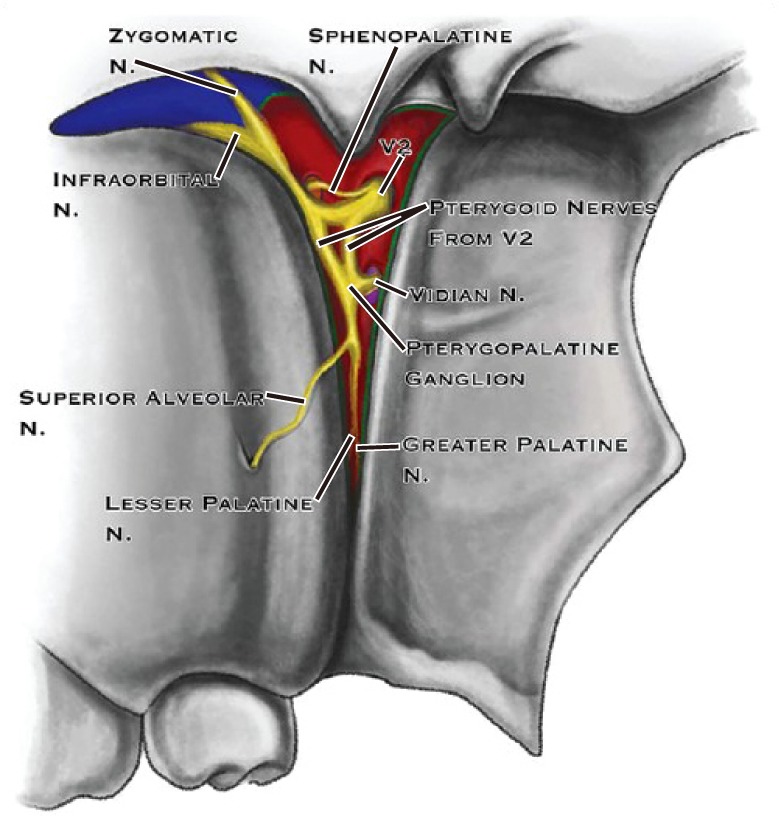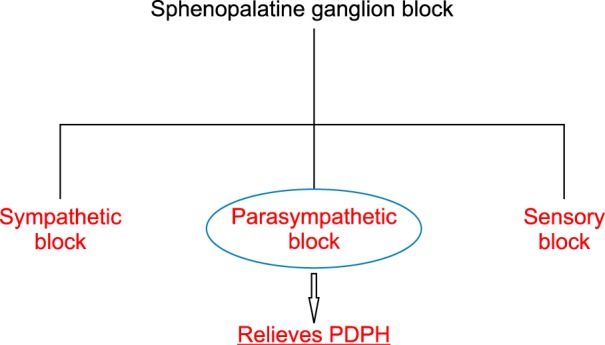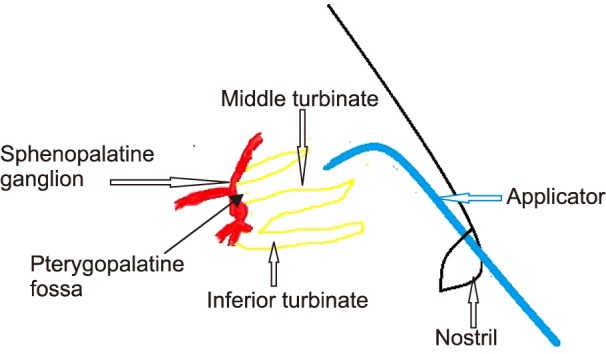Korean J Pain.
2017 Apr;30(2):93-97. 10.3344/kjp.2017.30.2.93.
Sphenopalatine ganglion block for relieving postdural puncture headache: technique and mechanism of action of block with a narrative review of efficacy
- Affiliations
-
- 1Department of Anaesthesia and Pain Medicine, Basavatarakam Indo-American Cancer Hospital and Research Centre, Hyderabad, India. abhijitnair95@gmail.com
- KMID: 2376044
- DOI: http://doi.org/10.3344/kjp.2017.30.2.93
Abstract
- The sphenopalatine ganglion (SPG) is a parasympathetic ganglion, located in the pterygopalatine fossa. The SPG block has been used for a long time for treating headaches of varying etiologies. For anesthesiologists, treating postdural puncture headaches (PDPH) has always been challenging. The epidural block patch (EBP) was the only option until researchers explored the role of the SPG block as a relatively simple and effective way to treat PDPH. Also, since the existing evidence proving the efficacy of the SPG block in PDPH is scarce, the block cannot be offered to all patients. EBP can be still considered if an SPG block is not able to alleviate pain due to PDPH.
Keyword
MeSH Terms
Figure
Cited by 2 articles
-
Bilateral transnasal sphenopalatine block for treating postdural puncture headache
Abhijit S. Nair
Korean J Anesthesiol. 2018;71(1):73-74. doi: 10.4097/kjae.2018.71.1.73.Efficacy of bilateral greater occipital nerve block in postdural puncture headache: a narrative review
Abhijit S. Nair, Praveen Kumar Kodisharapu, Poornachand Anne, Mohammad Salman Saifuddin, Christopher Asiel, Basanth Kumar Rayani
Korean J Pain. 2018;31(2):80-86. doi: 10.3344/kjp.2018.31.2.80.
Reference
-
1. Bano F, Haider S, Aftab S, Sultan ST. Comparison of 25-gauge, Quincke and Whitacre needles for postdural puncture headache in obstetric patients. J Coll Physicians Surg Pak. 2004; 14:647–650. PMID: 15530271.2. Boonmak P, Boonmak S. Epidural blood patching for preventing and treating post-dural puncture headache. Cochrane Database Syst Rev. 2010; CD001791. PMID: 20091522.
Article3. Ylönen P, Kokki H. Epidural blood patch for management of postdural puncture headache in adolescents. Acta Anaesthesiol Scand. 2002; 46:794–798. PMID: 12139533.
Article4. Desai MJ, Dave AP, Martin MB. Delayed radicular pain following two large volume epidural blood patches for post-lumbar puncture headache: a case report. Pain Physician. 2010; 13:257–262. PMID: 20495590.5. Khonsary SA, Ma Q, Villablanca P, Emerson J, Malkasian D. Clinical functional anatomy of the pterygopalatine ganglion, cephalgia and related dysautonomias: a review. Surg Neurol Int. 2013; 4:S422–S428. PMID: 24349865.
Article6. Rusu MC, Pop F. The anatomy of the sympathetic pathway through the pterygopalatine fossa in humans. Ann Anat. 2010; 192:17–22. PMID: 19939656.
Article7. Oluigbo CO, Makonnen G, Narouze S, Rezai AR. Sphenopalatine ganglion interventions: technical aspects and application. Prog Neurol Surg. 2011; 24:171–179. PMID: 21422787.
Article8. Candido KD, Massey ST, Sauer R, Darabad RR, Knezevic NN. A novel revision to the classical transnasal topical sphenopalatine ganglion block for the treatment of headache and facial pain. Pain Physician. 2013; 16:E769–E778. PMID: 24284858.9. Mokri B. The Monro-Kellie hypothesis: applications in CSF volume depletion. Neurology. 2001; 56:1746–1748. PMID: 11425944.
Article10. Piagkou M, Demesticha T, Troupis T, Vlasis K, Skandalakis P, Makri A, et al. The pterygopalatine ganglion and its role in various pain syndromes: from anatomy to clinical practice. Pain Pract. 2012; 12:399–412. PMID: 21956040.
Article11. Schaffer JT, Hunter BR, Ball KM, Weaver CS. Noninvasive sphenopalatine ganglion block for acute headache in the emergency department: a randomized placebo-controlled trial. Ann Emerg Med. 2015; 65:503–510. PMID: 25577713.
Article12. Cohen S, Trnovski S, Zada Y. A new interest in an old remedy for headache and backache for our obstetric patients: a sphenopalatine ganglion block. Anaesthesia. 2001; 56:606–607.
Article13. Cohen S, Sakr A, Katyal S, Chopra D. Sphenopalatine ganglion block for postdural puncture headache. Anaesthesia. 2009; 64:574–575.
Article14. Patel P, Zhao R, Cohen S, Mellender S, Shah S, Grubb W. Sphenopalatine ganglion block (SPGB) versus epidural blood patch (EBP) for accidental postdural puncture headache (PDPH) in obstetric patients: a retrospective observation. In : 32nd Annual Meeting of the American Academy of Pain Medicine; 2016 Feb 18-21; Palm Springs (CA). Poster #145.15. Kent S, Mehaffey G. Transnasal sphenopalatine ganglion block for the treatment of postdural puncture headache in the ED. Am J Emerg Med. 2015; 33:1714.e1–1714.e2.
Article
- Full Text Links
- Actions
-
Cited
- CITED
-
- Close
- Share
- Similar articles
-
- Efficacy of bilateral greater occipital nerve block in postdural puncture headache: a narrative review
- Bilateral transnasal sphenopalatine block for treating postdural puncture headache
- Headache and Pneumocephalus after Lumbar Epidural Block: A case report
- Effect of the Sitting Position after Spinal Anesthesia on the Incidence of Postdural Puncture Headaches: Saddle Block versus Low Spinal Anesthesia
- Stellate Ganglion Block for the Preventive Effect on the Attacks of Cluster Headache: A case report




